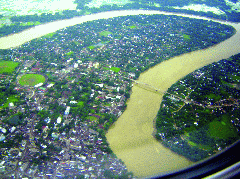Archives
Development
When asked about giving environmental clearance by his ministry, he replied that it is not a sure thing that a project will come up even after it is cleared environmentally.
Minister Jairam who has just returned from his China tour said, “I am not happy with the lack of an integrated system of environment clearance as there is no integrated system of clearance,” he said.
Interacting with journalists from 7 South Asian countries, he said that when he saw a news story on Bangladesh’s protest over Tipaimukh, he immediately informed his ministry officials to act on it before it became an international issue. Now Tipaimukh has become a ‘political football’, he felt.
Assuring that his ministry will address Bangladesh’s concern over the project, Mr. Jairam Raesh said that his ministry is also planning to discuss the issue with their Bangladesh counterparts. “We’re preparing to discuss it and we should address it,” he stated. He even asked the Dhaka University to collaborate with their Indian counterparts and take up joint environmental assessment programs relating to the burning climate change issue.
with their Bangladesh counterparts. “We’re preparing to discuss it and we should address it,” he stated. He even asked the Dhaka University to collaborate with their Indian counterparts and take up joint environmental assessment programs relating to the burning climate change issue.
Besides continuous protest over the proposed dam in Manipur, the main opposition Bangladesh Nationalist Party of former Prime Minister Khaleda Zia had also joined the protests staged by a section of environmentalists and NGOs who allege that the dam would affect the ecology of the entire region which forced a Bangladesh team to visit the dam site during the end of July this year.
The project site at Tipaimukh in Manipur, located 200 km upstream of Barak river from the Bangladesh border is high on the ‘talks’ agenda as the environmentalists expressed deep concern that if the 162 meter high dam is constructed on the confluence of Barak and Tuivai rivers in Manipur it could deprive Bangladesh of its share of the international river that supplies water to hundreds of water bodies including the biggest river Meghna in the region.
Many NGOs and environmentalists have been criticizing the government’s move to construct the Tipaimukh project on the confluence of Barak and Tuivai rivers on the grounds that it would seriously affect agricultural land, local flora and fauna, not to mention the displacement of people and livestock.
However, reports suggest that India still maintains that the project, required to generate power for its Northeastern region, will not hurt Bangladesh but instead will help control floods.
Senior officials of the National Hydro-electric Power Corporation, NHPC had even informed that the construction of Tipaimukh dam will take time, at least until the JVC (joint venture company) is formed. Though the Centre had appointed NHPC as the implementing agency for the project, it will now be a joint venture between NHPC (69 per cent), Shimla-based Satluj Jal Vidyut Nigam Limited (26 per cent) and the Manipur Government (5 per cent), Uday Sangker Sahi, NHPC Chief Engineer (Civil) told this reporter over phone.
Similarly the actual construction of South East Asia’s biggest hydel power project namely the 2000 MW Lower Subansiri hydel project in a contentious area of the Assam-Arunachal Pradesh border will begin later this year as the American engineering company, involved in the world’s biggest hydel project-the three gorge dam of China - is being commissioned for the project. NHPC is targeting to commission it by 2012.
Sobhapati Samom

